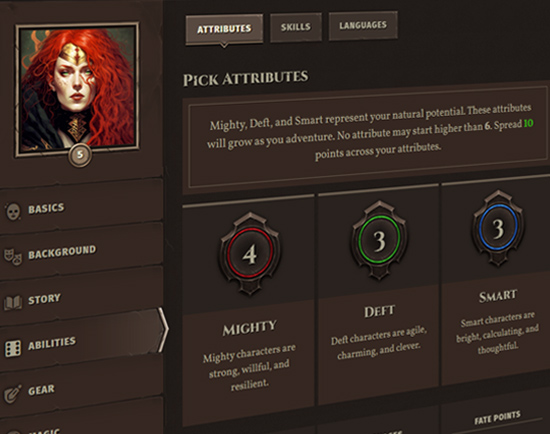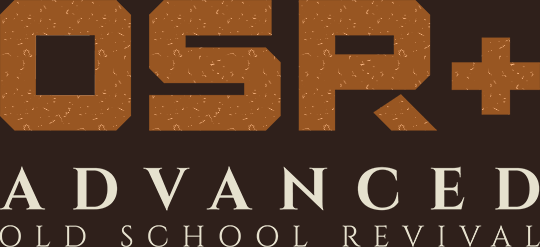The relative power of the abilities granted by origins, classes, and kits ranks in that order.
Origins
Origins don't have to represent fantasy races (or "species" depending on how you want to rationalize them in the fiction): an origin can also be interpreted to mean people from a particular political faction or different tribes of the North or even planes of existence. The core fantasy rules provide a handful of origins that imitate what you'd expect to see in a fantasy game, with some added flavor derived from the Quest of Queens campaign setting.
In general, origins grant talents, and talents are the only kind of ability that can grant broad advantage or disadvantage on an attribute. (Although they don't have to grant either.)
Moreover, the talents that origins grant tend to balance out across all origins to a net zero. For example, the Clockwerk talent Natural Armor grants an unarmored soak but requires PCs to repair themselves with gold when they rest; the High Person talent Arcane Affinity gets advantage on Smart but disadvantage on Mighty; the Changeling talent Shapeshift grants a limited form of shapeshift while also conferring disadvantage on Mighty. In all cases, the ability granted by the origin is offset by some form of drawback that results in a "net zero" gain mechanically.
Classes
The design of classes in OSR+ is not at all innovative, and that's on purpose: the technique that each class grants should sound familiar to anyone who's ever played another tabletop RPG or video game. Each technique was arrived at by reviewing hundreds of takes on the standard RPG fantasy classes from other tabletop RPGs and video games to try and produce a definitive set.
Classes are Irreducible
When creating new classes, you first have to ask yourself if the new class could in fact be derived from an existing class (in which case it would be a kit). Classes are the top-level taxonomic tier for organizing types of adventurers: they cannot be reduced to any other constituent part. In other words, classes are the "quarks" of an atom that is the adventurer.
As an example, in other traditional RPGs you'd expect to see mainstays such as the Druid, Barbarian, Monk, Sorcerer, and Warlock (these are all kits in OSR+). However, from a taxonomic point of view, it can be argued that the Druid is reducible to a kind of nature Cleric; a Barbarian to a kind of savage Fighter; a Monk to a martial arts-Cleric; and Sorcerers and Warlocks to Mage-like spellcasters, therefore they all fail this first test of irreducibility, and are better suited as kits. This way players can mix and match them with classes as they see fit (a Fighter Monk and a Cleric Monk each suggest a different character concept).
Technique Anatomy
The technique that a class provides always includes an active and a passive ability. For example, the Daredevil's Defy Danger ability grants 4 fate points instead of 3 (passive), and for 2 MP, Daredevils can take advantage on any non-attack roll (active). The abilities granted by techniques should be broad (but not spell-like) and capture the essence of the class you're creating.
Kits
From a categorization point of view, kits are a subtype of adventurer that spin out of classes. While the system sorts kits into five categories of utility (Charm, Combat, Magic, Skills, and Stealth) for the convenience of users of the website, kits actually derive from one or more classes, and are justified on the basis of whether they can function as a mold for character concepts. The review of all those takes on classes mentioned above, coupled with applying the first rule of irreducibility, led to a standard set of kits that was expanded over time into what you see today.
Kits as Character Concepts
When you develop a new kit, first consider what sort of character concept it serves. Kits are intended to be heavily thematic, meaning they're inspired by a specific trope or genre archetype in fantasy stories.
Concepts First, Not Mechanics
The wrong way to go about developing a kit is to think of a mechanic that's missing from the game and then try to retrofit a character concept to serve that mechanic. For example, say you really like shields and you want to build a PC who's good at using a shield in combat. Perhaps your inspiration is Captain America. So you start by coming up with a cool mechanic for shield-throwing and then try to work backwards to "people who use shields in popular media" in order to justify the kit.
While you might find several iconic characters who throw their shields in the wild (Link from Legends of Zelda, Wonder Woman, and Steven from "Steven Universe" come to mind), the act of "throwing a shield" is not a character concept, as it doesn't begin to describe who these characters are at a fundamental level.
Not only does this approach to building kits violate the principle of character concept-first design, but it also adds unnecessary mechanical complexity to the game. Characters can already use shields as a weapon (in fact, the Athletics skill helps with that). There's nothing stopping a character from throwing a shield as an attack, and if the player wants to benefit from the weapon tactic of the Thrown skill, the GM and the player can work together to make this happen in a number of ways: create a magical treasure, put a gold piece value on an armament that functions as both a weapon and a shield, or create a story hook that justifies its existence.
In other words, there's no need to create a mold for a single character.
Designing Kit Abilities
Once we've determined that there's a strong case for a character concept, the next step in developing a kit is to determine what abilities it should grant. Kits should grant far more narrow abilities than origins and classes, that help characters get an edge in the sort of unique situations they will find themselves in. In the case of the Tomb Raider, we know such characters will primarily be looking for treasure, and they're good at finding it. So the kit's ability ends up reading as:
Tomb Raider
Years of searching for secrets has taught you exactly what to look for. You may spend MP to create treasure-hunting typed supply: 1 MP for consumable, 3 for cheap, and 5 for luxury. Supply created in this way has no resale value. Whenever you recover supply, you always find at least 1 luxury.
In general, a kit ability should include both an active and a passive ability. The Tomb Raider can create treasure-hunting typed supply (active) and always recovers luxury supply (passive).
 Archetypes
Archetypes Armor
Armor Classes
Classes Conflicts
Conflicts Cultures
Cultures Ethos
Ethos Flaws
Flaws Glossary
Glossary Kits
Kits Maleficence
Maleficence Origins
Origins Shields
Shields Skills
Skills Spells
Spells Stances
Stances Status Effects
Status Effects Tactics
Tactics Talents
Talents Techniques
Techniques Treasure
Treasure Weapons
Weapons












 Hall of Heroes
Hall of Heroes Hall of Legends
Hall of Legends



 Dungeons & Flagons
Dungeons & Flagons